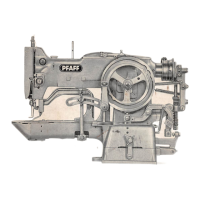c. Changing the Work Clomp Feet
To
exchange
the
work
clomp
feet,
take out set
screws
and
pull
the feet out
of their mount. Having attached the new feet, check to see that the needle
does
not
strike
them.
If
it
does,
adjust
the
position
of
the
work
clamp.
d.
Changing
the Feed Plate
The
feed plate can be
stripped
after
taking
out the
hexagon
screw.
When
attaching
the
new
feed plate,
check
to see that
its
holes
fit over the
position
pins exactly. If necessary, rework the holes with a reamer. Also moke sure
that
the
feed
plate
bears
against
the
needle
plate
lightly,
but
does
not
press
against it as
this
would
retard the
feeding
motion.
If
adjustment
is
required,
bend the feed plate slightly.
All
other ports
which
may
have to be exchanged are
listed
in
Section
Dof this
book.
7. Trouble Shooting
a. Skipped Stitches
(1)
Needle
bent.
(2)
Needle
incorrectly inserted.
(3)
Needle
too
fine
for
the
thread.
(4)
Needle rise timed inaccurately, or needle set either
too high or too low.
(5)
Shuttle set too far away from needle.
b. Thread Breaking
(1) For
any
of
the
causes
enumerated
above.
(2)
Needle point blunt or worn, or burrs and sharp edges
on
needle
plate.
(3)
Thread caught between tension discs or under bobbin case
tension
spring.
(4)
Poor or knotty
thread
used.
(5)
Thread tensions too loose or too tight.
c. Needle Breaking
(1)
Needle
bent.
(2)
Needle too fine for the fabric, or deflected by hard spots
in the material
and
struck by the point of the shuttle.
(3)
Stop cam spring broken, causing irregular stopping of machine.
(4)
Knives
timed improperly, causing needle to strike knives.
(5)
Machine
feeds
while
needle
is
down
in
material.
(6)
Needle not centered correctly in clamp feet cutout.
71

